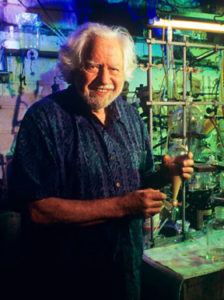Alexander Shulgin (1925-2014) is known as “the godfather of psychedelics.” Over the course of his life, he created, synthesized, and tested (on himself) hundreds of novel psychoactive compounds.
Shulgin studied chemistry on a Harvard scholarship when he was only 16 but left school in 1943 to join the Navy. He returned home to Berkeley after World War II and earned his doctorate in biochemistry from the University of California-Berkeley (UCB). He did postdoc work in pharmacology and psychiatry at the University of California-San Francisco (UCSF). He served as research director at Bio-Rad Laboratories then left to become a senior research chemist at The Dow Chemical Company.
The Start of Self-Experimentation
At Dow, Shulgin developed Zectran (mexacarbate), the first biodegradable pesticide for which he was granted a highly profitable patent in 1961. This accomplishment gave him the creative freedom to pursue research areas that interested him. He had tried mescaline for the first time in the late 1950s and it left such an impression on him he dedicated himself to researching new drugs, their effects, and mechanisms. Throughout the 1960s, Shulgin published papers on his new psychotropic discoveries, their synthesis, and possible therapeutic uses.1–9
Shulgin tested his discoveries on himself, starting with minute doses and slowly scaling up until he noticed an effect. After some of his friends joined the testing, he developed the Shulgin Rating Scale to standardize the way everyone reported the effects of the drugs.10 He and his friends also kept meticulous notes on the effects of the compounds.
In 1966, Shulgin ended his career with Dow amid bad press coverage at the time about street drugs. Dow had only asked that he refrain from publishing as an employee, but Shulgin elected to leave altogether to work as an independent consultant and researcher.
Working With the Drug Enforcement Agency
Shulgin spent two years at the UCSF School of Medicine studying neurology. He also taught classes at San Francisco General Hospital and local universities. It was also at this time that Shulgin formed a relationship with the US Drug Enforcement Agency’s (DEA) Western Laboratories. He held pharmacology seminars for DEA agents and supplied them with samples of the various compounds he had synthesized.
In related work, Shulgin authored the reference book “Controlled Substances: A Chemical and Legal Guide to the Federal Drug Laws.” It was considered the definitive reference guide for law enforcement. Shulgin launched his private consultancy by setting up a home-based laboratory known as “the Farm” on his property and got a DEA Schedule I license.
MDMA
In 1976, a student at San Francisco State University was the first to give Shulgin MDMA (3,4-methyl enedioxy methamphetamine, also known as ‘ecstasy’ or ‘molly’). Shulgin developed a new synthesis method to get around a patent Merck had at the time (Merck patented MDMA as an intermediate to make other compounds but never investigated its effects).
In the same year, Shulgin introduced his psychologist colleague Leo Zeff to MDMA. Zeff started using it to augment talk therapy in his psychotherapy practice and ultimately introduced it to hundreds of other psychologists and lay therapists. Shulgin continued to discover, describe, and synthesize novel psychotropic compounds over the decades 11,12 and define possible mechanisms of action.13–16
Sharing the Knowledge – PiHKAL and TiHKAL
In the 1990s, Shulgin and his wife Ann published two books, “PiHKAL: A Chemical Love Story” (1991) and “TiHKAL: The Continuation” (1997). PiHKAL and TiHKAL are acronyms for “Phenethylamines I Have Known and Loved” and “Tryptamines I Have Known and Loved,” respectively. Amid stories and essays, the books contained detailed information on psychoactive compounds, many of which Shulgin discovered. The information included chemical structure, synthesis instructions, dosages, bioassays, and other qualitative information.
The books were written with the main purpose of making the information available to the public—not confining it to research labs. The Shulgin’s believed psychedelics can be valuable tools for self-exploration, and they protected the public’s access to the information by publishing the information.
Stepping Over the Line
In 1994, the DEA raided Shulgin’s lab. They fined him $25,000 for having anonymous chemical samples in his possession that were sent to him for quality testing. He was asked to hand over his Schedule I license because of this violation. Over the previous 15 years, Shulgin had scheduled and undergone two DEA reviews of his lab which found no issues.
To some, the raid seemed to be no coincidence because PiHKAL had come out only a few years before. Richard Meyer who was a spokesman for the DEAs San Francisco Field Division at the time said, “It is our opinion that those books are pretty much cookbooks on how to make illegal drugs. Agents tell me that in clandestine labs that they have raided, they have found copies of those books.” 17
Dr. Shulgin ws also an early member of the Scientific Advisory Board for the Beckley Foundation. More information on Dr. Shulgin is found on the Alexander Shulgin Research Institute website.

